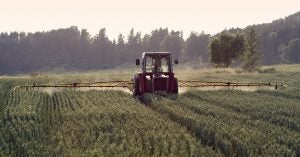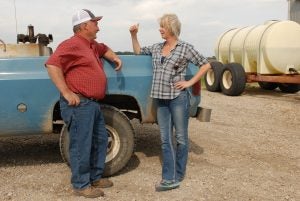New guidance to maximize every drop of fertilizer in Ohio and beyond
 Applying the right amount of fertilizer to a grower’s field is tricky: too little fertilizer means lost yields; too much fertilizer means wasted costs and potential runoff that causes air and water pollution. Meanwhile, farmers cannot control the weather, which can wreak havoc on the best-laid plans.
Applying the right amount of fertilizer to a grower’s field is tricky: too little fertilizer means lost yields; too much fertilizer means wasted costs and potential runoff that causes air and water pollution. Meanwhile, farmers cannot control the weather, which can wreak havoc on the best-laid plans.
One important tool used to answer the question of the right rate, timing, placement and source of nutrient application to croplands (the “4Rs”) is on-farm research trials. Farmers establish trials using their own fields and equipment, usually with guidance from a trusted advisor, university researcher or extension agent. Trials can inform many practices like nutrient management and seeding rate. Typically, they are conducted to determine practices’ effects on yield, nutrient use efficiency, soil health and profitability.
Using the data generated from these field trials, experts are now updating the Tri-State Fertility Guide for Corn, Soybean, Wheat and Alfalfa. This 22-year old document still serves as the main guidance on fertilizer applications for the Buckeye state as well as Michigan and Indiana.
Here’s how the update will benefit farmers.
[Tweet “New guidance to maximize every drop of fertilizer in Ohio and beyond, via @KaMcChapmanhttps://edf.org/7dE”]
Maximum Return to Nitrogen
“We’re looking at farmer profitability as the primary target.” Steve Culman, Soil Fertility Specialist at Ohio State University
The guide would benefit significantly from an influx of more recent data collected on farms using modern equipment, hybrids and management practices. The guide, which still relies on the outdated yield-based goal approach to determine nutrient application rates, also would benefit from a greater focus on “Maximum Return to Nitrogen” (MRTN), a newer approach to rate recommendations developed by a number of land grant universities.
For this reason, many Corn Belt states adopted the MRTN calculator, which is informed by on-farm or university research trials, as the preferred method of recommending the right rate of N for a given farm.
Profitability over yield
 In Ohio, fertility experts are moving away from yield-goal based recommendations still featured in the Tri-State guide.
In Ohio, fertility experts are moving away from yield-goal based recommendations still featured in the Tri-State guide.
“We’re looking at farmer profitability as the primary target,” says Steve Culman, Soil Fertility Specialist at Ohio State University (OSU). Steve is leading efforts to update the Tri-State Guide using data from on-farm research trials. So far, his team has conducted 150 trials testing nitrogen, phosphorus and potassium rates in order to fine tune guidance.
Since farm income has been suffering during the past four years, Culman feels a particular obligation to advise farmers on economic models that work for them. “In an era of variable grain prices and variable nitrogen fertilizer prices, it’s an economic model that accounts for those uncertainties and helps farmers,” he said.
Maumee Farmer Network
Over the past nine years, EDF and independent crop consultants in the Lake Erie basin and beyond have collected data from 200 trials on nitrogen rate through the Maumee Farmer Network. Participating farmers received information after each season with a “post-mortem” report on how close they were to optimizing their nutrient rate on their own farms – and to obtaining the most yield and profit from each pound of fertilizer used.
After two to three years participating in the program, farmers saw trends that informed their management decisions in the next season. Some increased fertilizer use on certain acres while decreasing its use on others – the trick is to learn where that makes sense according to the soil biology and its ability to process nutrients for greater uptake into the crop, to optimize fertilizer use, not necessarily minimize fertilizer use.
These data collected will supplement the OSU effort, while all of the trial data will used to inform the new Tri-State recommendations.
The more regional data can be collected, interpreted, shared and understood, the better off farmers and the environment will be.
Related:
New guidebook explains how and why to build a farmer network >>
Farmers’ voices are essential to sustainability. Let’s listen up >>
From my grandfather’s farm to NutrientStar: Why I believe in growers >>













2 Comments
What percent of the total N uptake by corn has occurred at the time of the last N application? Chances are that it is <30% unless a high-clearance applicator or fertigation is available. This brings to mind the variability from year to year for the NTRM recommendation. What are the opportunities for adaptive N management using remote sensing?
Good question Jim! Conducting and using information from on-farm research trials is a great way to collect relevant data for regional conditions and recommendations, but remote sensing may provide another option for growers. It will be interesting to see data from trials using remote sensing as a tool.